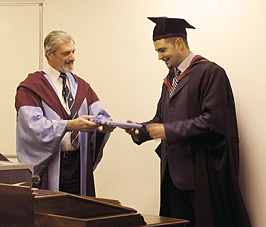Analysis and Comparison of Contact-Force Models for Distinct Element Simulations of Fluidised Beds
 Alberto di Renzo recently passed his Viva for a Master of Philosophy at the Wessex Institute of Technology.
Alberto di Renzo recently passed his Viva for a Master of Philosophy at the Wessex Institute of Technology.
Alberto's thesis is entitled "Analysis and comparison of contact-force models for distinct element simulations of fluidised beds". He carried out his research under the supervision of Dr Viktor Popov, Head of the Environmental Fluid Mechanics Division at WIT. His External Examiner was Professor Mojtaba Ghadiri from the University of Leeds, and Prof Carlos Brebbia acted as the Internal Examiner.
Alberto's work is concerned with the analysis and comparison of three contact force-displacement models for distinct element simulations of complex two-phase systems such as fluidised beds. Following the original Distinct Element Method (DEM), the solid particulate phase is modelled as an ensemble of many particles subjected to external forces acting on each particle.
A linear model has been used by most authors for the contact forces in the field of granular flow simulation, whereas simplified non-linear models were investigated only in a few cases. Alberto has instead implemented two non-linear models in addition to the linear case. These models were based on the simplified and full non-linear theory of HERTZ-MINDLIN and DERESIEWICZ and subjected to tests on different scales in order to assess the simulation capabilities of the models.
A series of tests were conducted by Alberto on the elementary case of a frictional elastic collision of a single sphere on a flat wall at several impact angles. The macroscopic solution obtained using the three models is validated and compared for accuracy against a set of experimental values. The evolution of forces, velocities and displacements was compared with an approximate analytical solution. On a macroscopic scale, the contact models were used for the simulation of an idealised system representing a fluidised bed and the results were assessed for physical consistency and numerical efficiency.
Alberto concluded by presenting a set of guidelines for the correct choice of contact model depending on the system to simulate and the type of process under analysis.
The examiners were most impressed by Alberto's work and congratulated him on the quality of his thesis. The work is outstanding and amply satisfies the requirements for a Master of Philosophy thesis.

 Wessex Institute
Wessex Institute